This post may contain affiliate links. For more information, see our privacy policy.
These No-Knead Potato Rolls are soft, slightly sweet and have a super tender texture. Made with potato flakes, the easy recipes comes together with minimal effort!
I got in a little trouble at Thanksgiving back in November. I was in charge of bringing bread but not just any bread. All of the grandchildren go crazy over my No-Knead Pull Apart Bread and request it for every holiday and family dinner. I thought 3 loaves would be plenty but several long faces, when the basket was empty, told me otherwise. So when I made these No-Knead Potato Rolls for Christmas (along with plenty of loaves of pull-apart bread) and the kids couldn't decide which they liked better, I knew we had a hit!
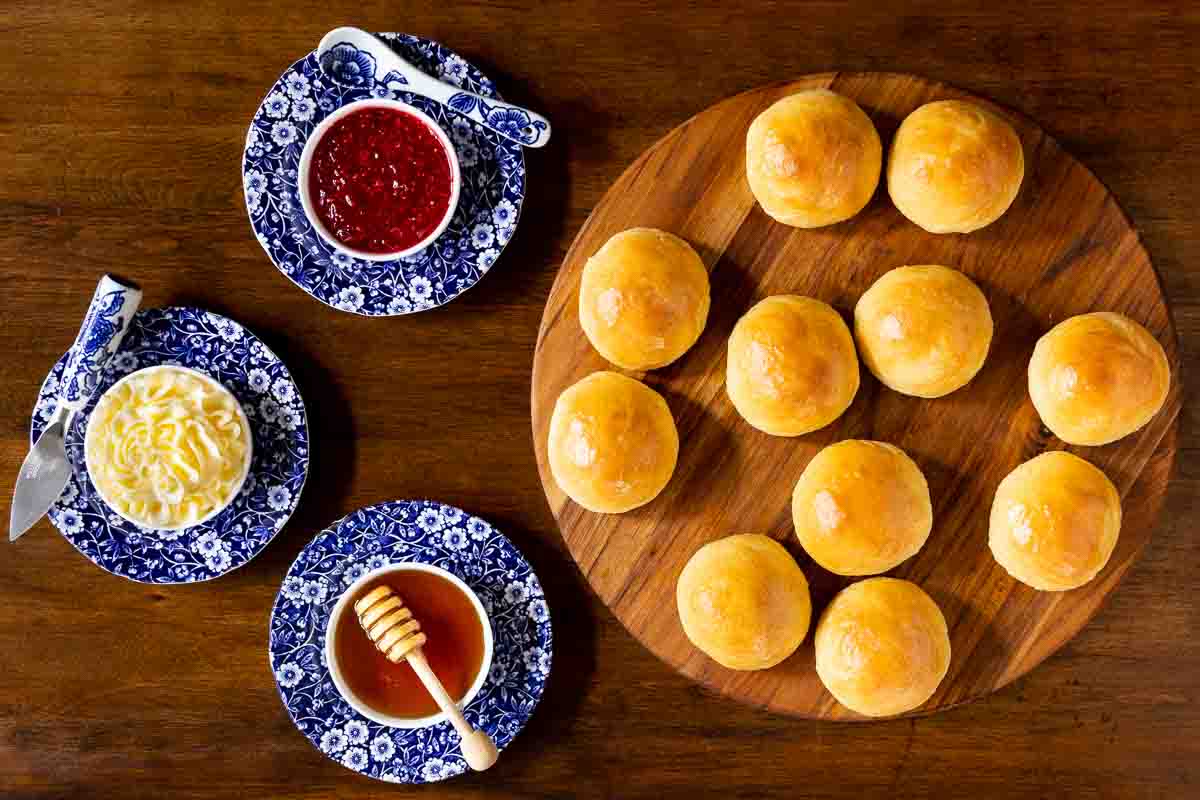
Potatoes in bread?
I'm not sure who originally came up with the age-old idea of using potatoes in bread recipes but I suspect it was some practical soul who didn't like waste. It turns out that it was a brilliant idea as potatoes, according to King Arthur (the baking gurus), "are the secret to ultra-tender, ultra-soft bread and rolls".
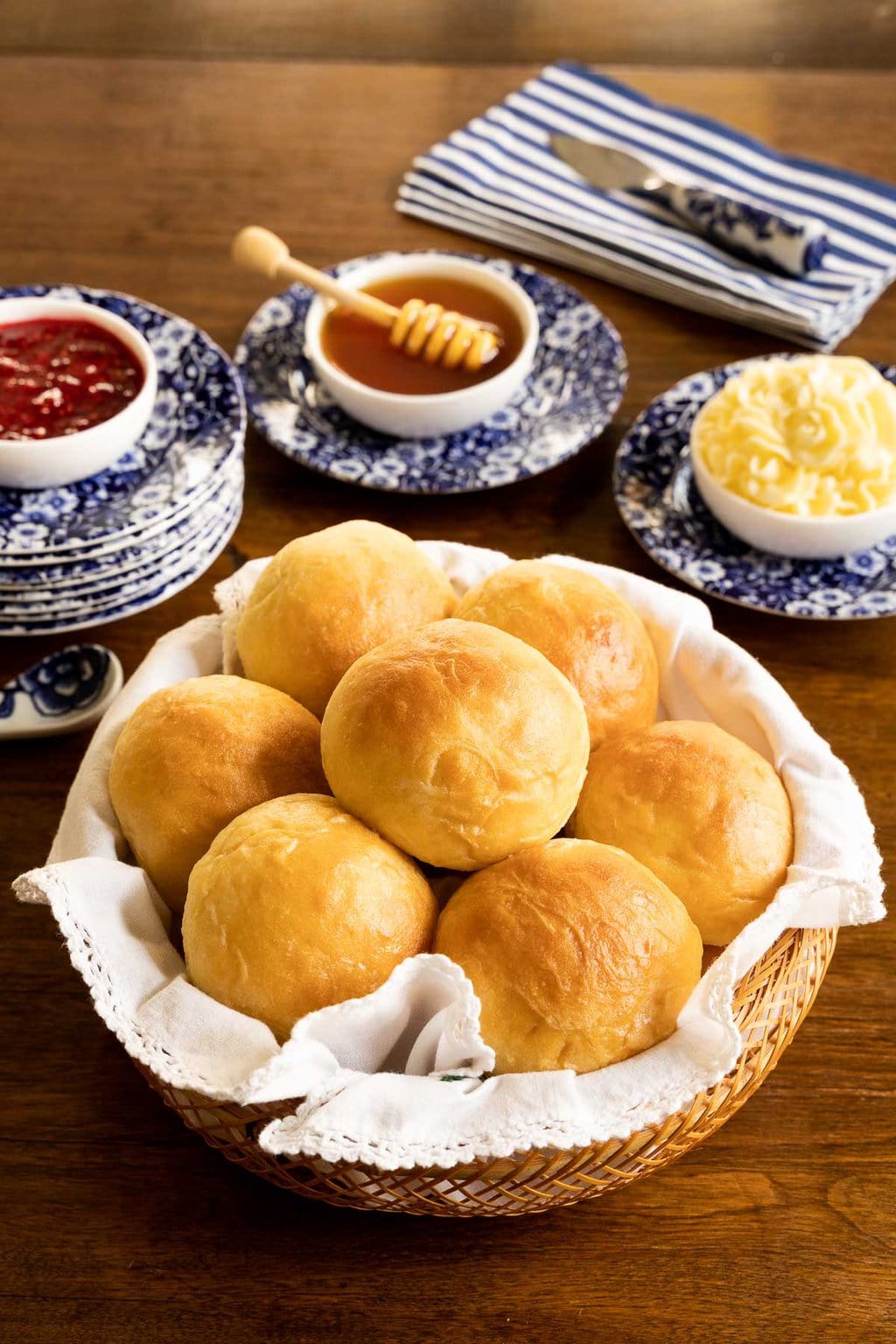
How does the humble potato work its starchy magic?
Why do potatoes have such a magical ability to create light, airy, tender bread? In the old days, bakers just knew it worked but these days there are actually scientific explanations. Here's how Southern Living Magazine explains it: "the different actions/reactions between potato starches and wheat starches create an incredibly soft loaf of bread". Here are the four ways potato starches work to do that:
- Potatoes are rich in potassium which causes yeast to rise faster than it would with dough that contains only wheat starch.
- Potato starches attract and hold more water than wheat starches which helps to increase the moisture content in baked goods. They also make yeast dough easier to shape and handle.
- Potatoes help create a delicate crumb. When potatoes are boiled, the starch molecules enlarge, making it difficult for the proteins in the flour to form gluten. Too much gluten is the nemesis of light, airy breads and pastries.
- Lastly, potatoes help create a longer shelf life for bread. As baked bread cools, starches begin to crystallize and trap water inside the crystals, causing the bread to harden and dry out. When bread contains potatoes, however, the potato starch molecules make it harder for the wheat starches to crystallize, keeping the bread fresh and soft for a longer period of time
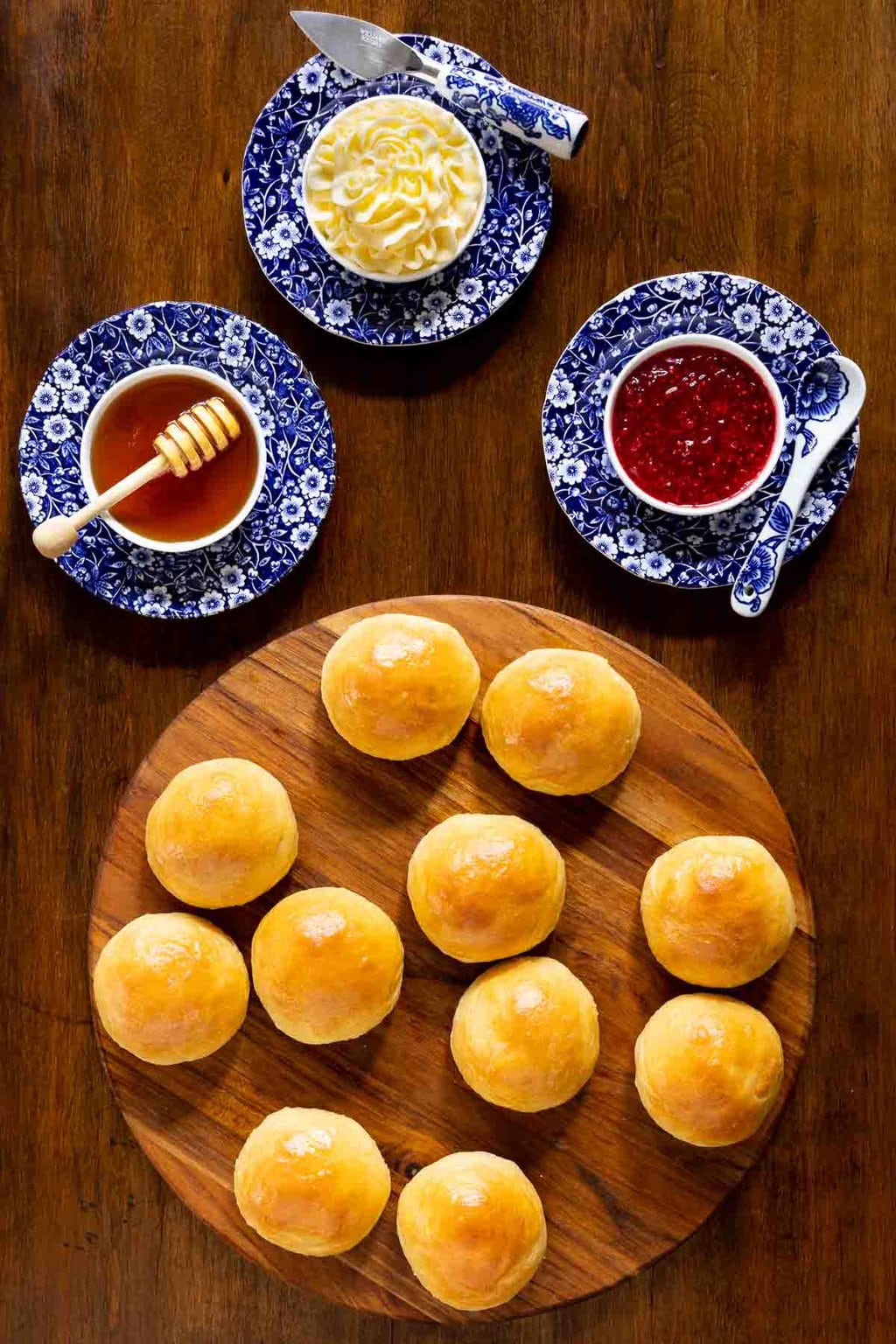
Potato water
Smart (and frugal) bakers over the years have also discovered that simply using the water that potatoes are cooked in gives similar benefits to those listed above. A good deal of starch is leached out of potatoes as they're boiled making the leftover water a bread baker's treasure.
No potato water? No problem!
Since many of us don't regularly have leftover potato water, I decided to go with an easy sub for these No Knead Potato Rolls; potato flakes (aka instant mashed potatoes). I love that I can keep a box of potato flakes in my pantry and make my own potato water in less than a minute.
To make potato water, simply combine 4 tablespoons of potato flakes per cup of warm water (this recipe calls for 3 tablespoons in ¾ cup of water).

One size doesn't fit all...
Although this recipe (as written below) yields 20 perfect-sized dinner rolls, it also makes fantastic sandwich rolls portioned just a bit bigger. I use a scale as I am lousy at dividing dough into equal portions. For dinner rolls, I like them right around 1.8 ounces (50g).
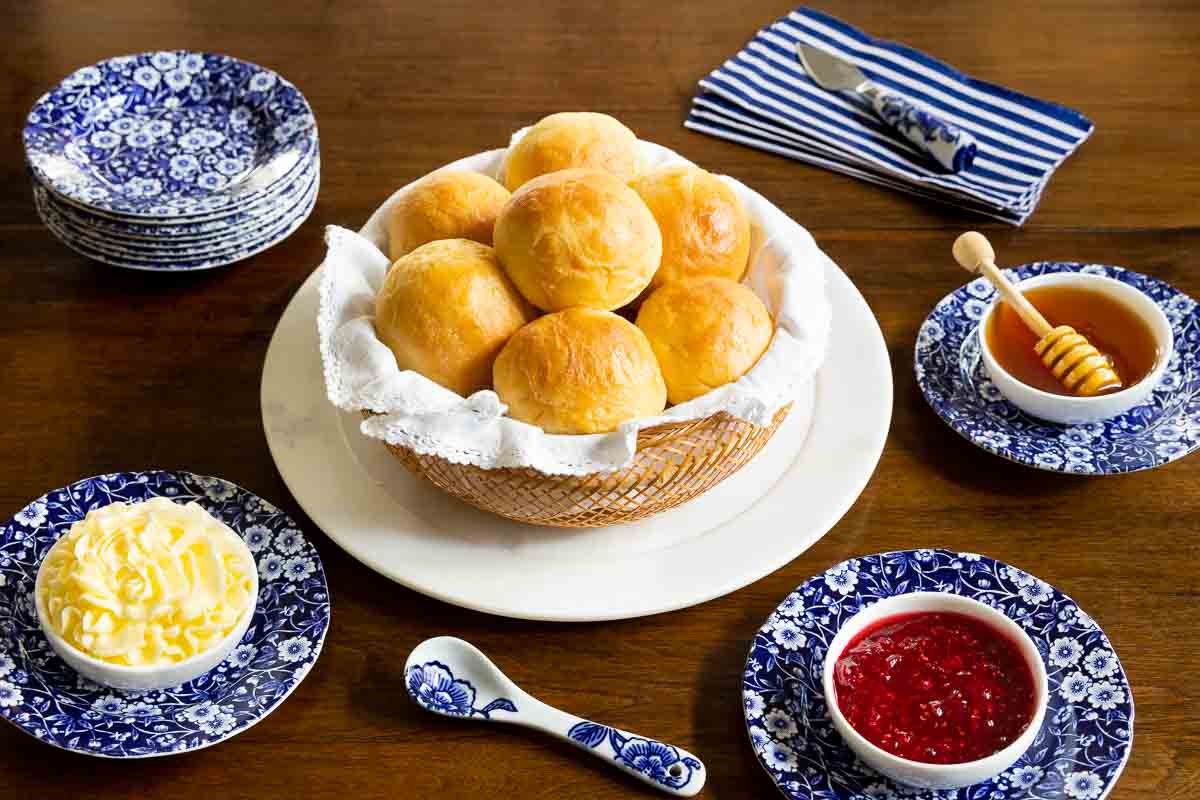
For sandwich rolls, I portion them 2.25 to 2.5 ounces(65-70g).
You could also portion this dough into 2 free-form round or oval loaves, each one weighing 16-18 ounces or 450-500g.
Any time of day!
I've mentioned serving these No-Knead Potato Rolls for dinner in the bread basket but they're also great for breakfast, served with jam (our Easy Raspberry Jam is pictured) or marmalade.

Or make some fluffy scrambled eggs and served them stuffed between these rolls for a fabulous breakfast sandwich. (I'm enjoying one of those right now, as I write - DELISH!) Add a strip or two of crispy, smoky bacon for breakfast nirvana!
Slice them open and spread each cut side with honey mustard then layer with thinly sliced deli turky or ham and Gouda or Havarti cheese - you've got delicious little sliders people will fight over!
Actually, whenever and however you serve these rolls, people will fight over them so be sure to make plenty (or you'll get in trouble like I did). Put them on your must-make-soon list!
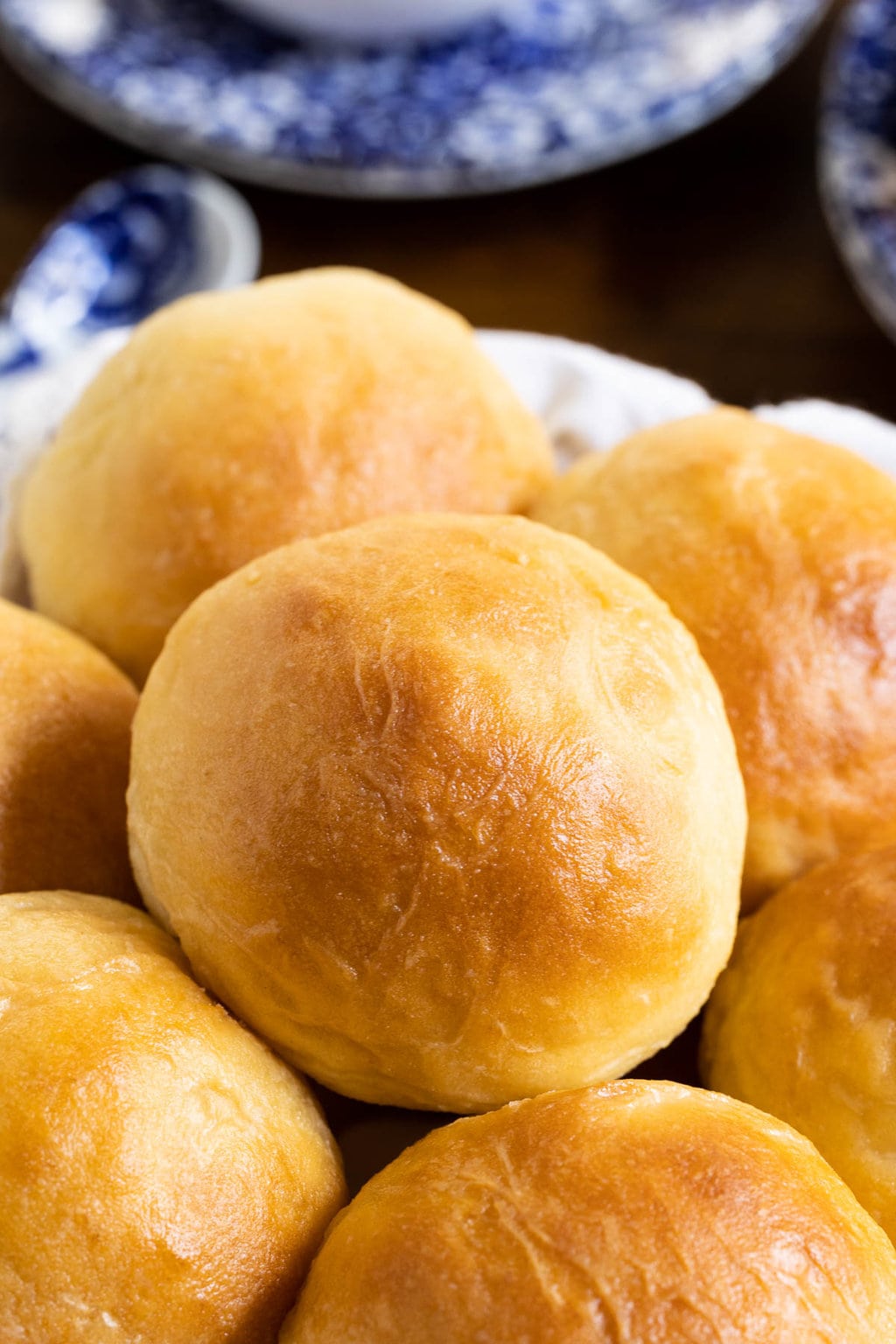
Café Tips for making these No-Knead Potato Rolls
- Yeast dough likes a warm, cozy place to hang out. If your house is chilly, there are a few things you can do to create a nice warm yeast-friendly place.
- Turn your oven to 350˚F for 2 minutes then turn the oven off. Leave the light on and place your dough in the oven.
- Vigorously boil a cup of water in the microwave for 4-5 minutes. This will create a lot of nice, warm steam. Place dough in the microwave and close the door.
- Set the bowl in the sink in a larger bowl of hot water.
- If you have a load of laundry drying, set the covered bowl on top of the dryer. Make sure you have it on a towel, or it might “wander” off the top of your dryer - that would be really sad!
- Place the bowl on a heating pad.
- This recipe calls for bread flour or all-purpose flour. I like to use bread flour as it has a higher protein content which makes the dough a little more stable and yields a slightly higher rise. That being said, I've also used all-purpose flour for these rolls with good success.
- You need instant yeast for this recipe. Instant yeast is available at most grocery stores. It's sometimes called rapid-rise yeast, quick-rise yeast or bread machine yeast. I like to buy my instant yeast in bulk as it's infinitley cheaper than purchasing the little packets. I will keep for months in the refrigerator and indefinitely in the freezer. I keep a small jar in the refrigerator at all times and the rest in the freezer. I refill my little jar as needed.
- I make my own potato water with instant potato flakes. I like Idahoan Original Mashed Potatoes (available at most grocery stores) and Bob's Red Mill Potatoes. They're both made with genuine russet potatoes. Once opened, potato flakes have an average shelf life of 6 to 12 months, so you can makes lots of these No-Knead Potato Rolls! I keep my potato flakes in a ziplock bag or airtight storage container.
- If you're cooking potatoes, by all means, use ¾ cup of the leftover potato water in lieu of the water and potato flakes in this recipe.
- Don't be afraid to generously flour your work surface when shaping these dinner rolls. For years, I had trouble making bread and would get so frustrated because the dough would stick to the counter or my hands and everything would be a big mess. I finally learned that I just wasn't using enough flour. Don't overdo the flour but use enough so that the dough isn't sticky.
- This dough is thick. I like to use a heavy-duty spatula with a wooden handle to mix it up or a Danish whisk. A Danish whisk is wonderful for mixing up all kinds of batters.
- If your baked rolls seem to get too brown on the underside, your oven may run a little hot near the bottom. To remedy this, use a second sheet pan underneath the parchment-lined pan.
Thought for the day:
Because of the Lord’s great love, we are not consumed,
for His compassions never fail.
They are new every morning;
great is Your faithfulness.
I say to myself, “The Lord is my portion;
therefore I will wait for Him.”
Lamentations 3:22-24
What we're listening to for inspiration:
If you enjoy this recipe, please leave a star rating and review! It’s so helpful to other readers to hear your results, adaptations, and ideas for variations.

- 3 ½ cups all-purpose or bread flour
- ⅓ cup sugar
- 2 teaspoons kosher salt I use Morton - you'll need less if you use Diamond
- ¾ ounce instant yeast 2¼ teaspoons or 1 packet
- 4 tablespoons butter I used salted butter
- ½ cup milk
- 1 large egg
- 2 egg yolks from large eggs
- ¾ cup hot tap water
- 3 tablespoons potato flakes
- 1-2 tablespoons melted butter
-
Line 2 sheet pans with parchment paper for easy cleanup. Set aside.
-
Combine flour, salt, yeast, and sugar in a medium-large bowl. Stir well to combine. Set aside.
-
Place butter in a medium-size microwave-safe bowl and cook on high power for 40-60 seconds or until melted. Stir in the milk then add the egg and yolks and stir well. Combine the hot water and potato flakes. Stir for 15-20 seconds to dissolve the potato flakes. Make a well in the center of the flour mixture. Add the egg/milk mixture and the potato water. Stir, from the bottom up, until the dough comes together in a shaggy mass. The dough will be thick. Keep scraping the sides and bottom of the bowl until every last bit of flour is incorporated.
-
Drizzle a little oil (I use olive oil but any oil will do) over the top of the dough to keep it from drying out. Cover the bowl with plastic wrap or a plate and set the bowl in a warm place (see Café Tips above in the post for how to create a warm, cozy rising spot) for 1-1 ½ hours or until the dough is doubled in size.
-
Sprinkle ¼ cup of flour onto a work surface. Scrape the dough onto the floured surface. Turn the dough with a dough scraper or spatula until it’s thoroughly coated with flour.
-
Divide the dough into 20 portions, each one about 1.8 ounces (or 50g). (I like to use a kitchen scale for this but you can just eyeball it.) Roll each ball of dough to coat with flour. (You may need a bit more flour.)
-
Holding a piece of dough in your dominant hand, tuck the edges under with the other hand , rotating the dough so that all the edges get tucked under and the top has formed a smooth round ball. (If the dough feels sticky while shaping the rolls, just roll it in a little more flour.)
-
You can stop at this point and place the dough balls on the prepared baking sheets but here’s how to form perfect balls - put a drop or two of oil (again I use olive oil but any oil will do) on a clean area of your counter. Rub the oil with your hand to create a thin coating on the counter surface. Now place one of the tucked under balls of dough on this oiled area and roll it with your hand to create a perfectly round ball. Place the ball of dough on one of the prepared sheet pans. Repeat with remaining portions of dough.
-
Cover rolls with a clean kitchen towel and allow to rise for 30-45 minutes in a warm area. They should start to puff up but won’t be doubled in size this time.
-
Preheat the oven to 350˚F.
-
Place the rolls in the oven and bake for 17-20 minutes or until medium golden brown. Brush each roll with the melted butter then transfer rolls to a cooling rack or serve warm slathered with butter and jam or honey (SO good!).
-
When completely cooled rolls can be transferred to an airtight container or can be frozen. Warm in the oven for a few minutes before serving.
See Café Tips above in the post for more detailed instructions and tips to ensure success.
If you prefer to use Metric measurements there is a button in each of our recipes, right above the word “Instructions”. Just click that button to toggle to grams, milliliters, etc. If you ever come across one of our recipes that doesn't have the Metric conversion (some of the older recipes may not), feel free to leave a comment and I will add it.
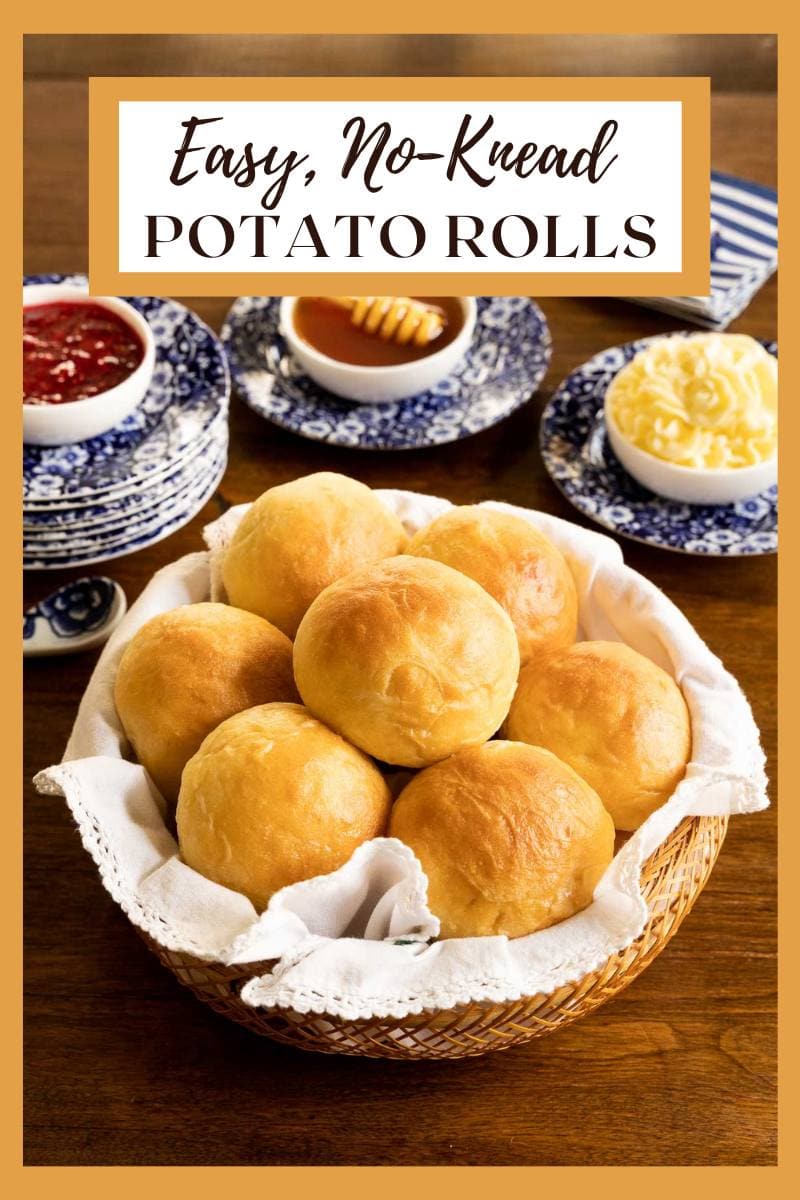


Martha says
Are you freezing the rolls after they are cooked or freezing the rolls then thawing and baking?
Chris Scheuer says
Hi Martha,
I generally freeze them after baking.
Susan says
Please clarify if the metric amount for the yeast is 7 grams as the recipe just has the number 7 in front of "package of yeast".
Thank you,
Susan
British Columbia, Canada
Chris Scheuer says
Hi Susan, it is 7g of instant yeast. Sorry that was confusing! I have clarified that in the recipe. Thanks!
Maria Nienhouse says
I love all of your recipes and made many of them, but this is one of my favorites! I'm a novice at making bread and rolls, but my husband is addicted to these. I'm now having to make them larger to use as hamburger and sandwich buns! Thank goodness they freeze well because I am making them often.😂 I made them for Easter and my daughter grabbed one off of the pan the minute they came out of the oven, even though they were hot! Of course, she took some home!! Thank you for always having amazing recipes, but also for the inspirational messages and suggested songs! They always are exactly what I needed at the time!!
Lindsay @ The Café Sucre Farine says
That's great, Maria! Thank you for taking the time to let us know 🙂
Donna Barton says
Potato flakes..genius!!!!
Donna
Lindsay @ The Café Sucre Farine says
Enjoy, Donna!
Paul says
I think you needlessly complicated this concept. The fact is anyone can add potato to ANY bread recipe easily. Potatoes are perfectly hydrated in and of themselves. You don't need to worry about adding or subtracting liquid to any bread recipe.
So peel one medium russet (brown baking type) potato. Slice into ½ inch coins. Drop into large pot of boiling water. When water returns to boil, time exactly 10 minutes, dip out potato with slotted spoon and rice onto dinner plate. Cool a little and save cooking water to make the bread. Simple. One potato per 3½ cups in your recipe. Leave the the peel on (scrub with brush first) if you want rustic effect!
Chris Scheuer says
Thanks Paul! I’m always looking for ways to save time as our readers live very busy lifestyles and this is a method to make incredibly delicious rolls with minimal effort. But you are obviously very knowledgeable. You might need to start your own website!
Norma C Roberts says
I'm just wondering about the amount of salt used. I usually salt the water for my potatoes. Would it be better to just omit the additional salt for the recipe? TIA
Chris Scheuer says
You could definitely cut back on the salt, Norma! If you salt your potato water, that would be good!
Avis G Long says
I have ALWAYS been scared of yeast recipes but yours plus adding potato flake water causes me to try my luck at roll making again!! Your attention to details along with excellent hints should make even a young cook comfortable. I'm a seasoned cook and always glad to learn new skills and always will share giving credit when do. I can't wait for next shopping to stock up on needed items. Then baking I'll be doing. God's blessings on you!
Chris Scheuer says
Hope you are wildly successful with this recipe, Avis!
Renee’ says
Chris have you tried this with gluten-free flour? If not, any suggestions for me to try it?
Chris Scheuer says
Hi Renee’, I haven't tried these rolls with GF flour. All of our scone and biscuit recipes work well with GF flour but I haven't had too much success with GF yeast recipes. However, my nephew is an expert at GF recipes and he has a recipe website. Check it out here: https://cakesandcoriander.com
Patricia says
After the potato water is mixed, what should the consistency be like?
Chris Scheuer says
Hi Patricia, the consistency will be a little thicker than water.